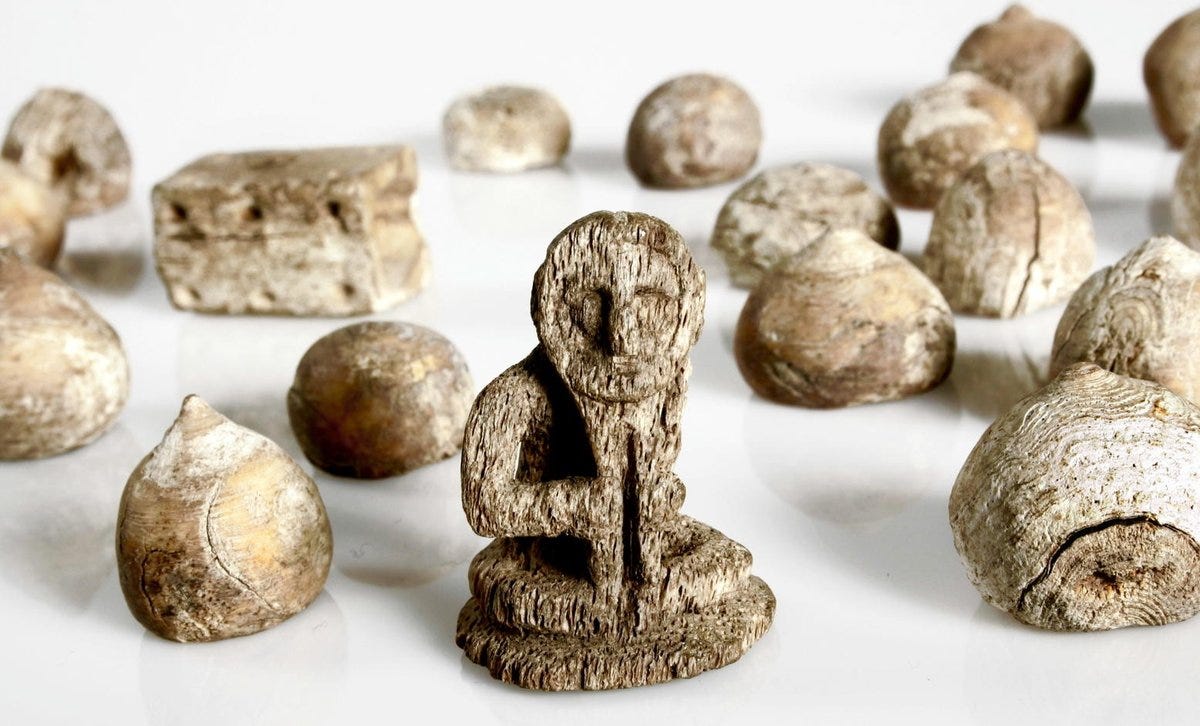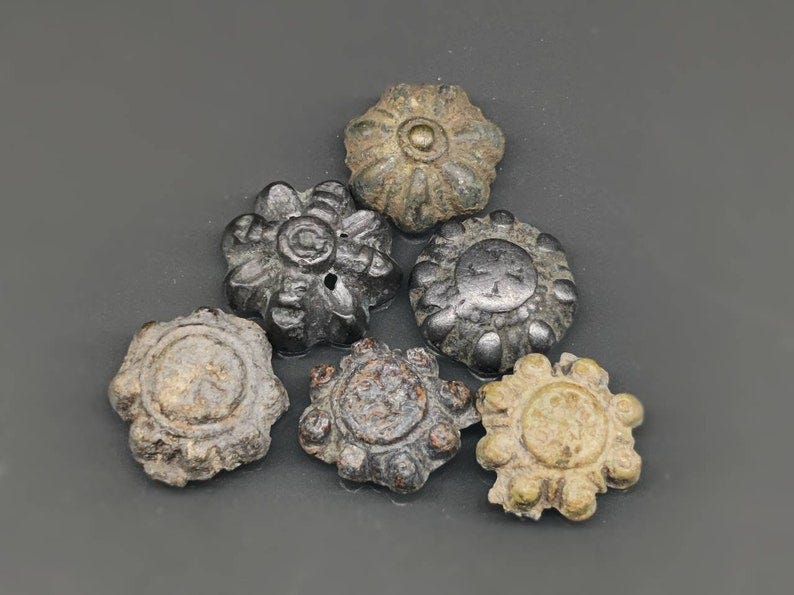From the Voluspa, the Prophesy of the Volva
58. The Aesir meet
on Ithavoll
and regard
the bones of the Midgard-serpent,
and there they recall
the great events of Ragnarok,
and Odin’s
old wisdom.
59. There they will find once more
the wonderful
golden game pieces
in the grass,
which they had once played with
in the earliest days.
Voluspa v. 58 and 59, Jackson Crawford translation, The Poetic Edda, Indianapolis, Indiana: Hackett Publishing, 2015
The game the gods were playing seems likely to have been hnefatafl, a war game similar to chess that was popular throughout northern Europe at one time. Tafl game markers and boards have been found in archeological sites wherever the Vikings lived and traveled—in Sweden, England, Ireland and Iceland. They were made in various shapes and with whatever materials were available. It involved two uneven sets of markers and a king set apart from the others by size and design.
This is a set of glass hnefatafl markers from the Swedish History Museum.
And here is a whalebone set from Baldursheimer, Iceland.
And, finally, some simple bronze and lead pieces from Ukraine.
At one point in the past, the working title of my Norse duology was Game Pieces of the Gods. It seemed to me that “game pieces” was a good metaphor for the role of humans in Norse myth. Like the pantheons of Roman and Greek mythology, the Norse gods often meddled in Midgard, the human world, for their own selfish reasons.
Odin prepared for the catastrophe at Ragnarok by reaping the great warriors of the human world and housing them in his hall, Valhalla, to fight by his side in the last days. He did not hesitate to take sides in battles and conflicts in Midgard if it would strengthen his hand at Ragnarok. Or just for the hel of it.
In a way, the gods themselves were game pieces of the Norns, mysterious women who lived at the base of the Tree of Life and shaped the lives of all beings. This fate-crafting is often described in terms of spinning and weaving a web of life, or Wyrd. Neither human nor god could change the future woven for them, bargain their way out, destroy or escape it. All they could do is choose to meet their fate with honor. Or not.
Thanks to the prophesy of the volva, Odin knew Ragnarok was coming, but he couldn’t prevent it or change the outcome, though he certainly tried. In fact, it became an obsession of his. Be very afraid of a god with an obsession.
I integrated the “golden game pieces” from the Voluspa into the Runestone Saga. Children of Ragnarok takes place in the world after the last battle. I would compare it to Mos Isley’s Cantina—filled with refugees from all of the Nine Worlds—demons, outlaws, ice wolves, jotun—and even some who claim to descend from the gods. Magic of all kinds is suspect—its practitioners killed or driven into exile by the increasingly desperate population.
Many small farmers in the archipelago have turned to coasting—summerlong raiding to supplement dwindling crops. Coaster Eiric Halvorsen’s late fadir and grandfadir brought back many treasures from their summer raids—including some extraordinary game pieces made of gold. When Eiric is accused of killing his stepfadir Sten, he offers the game pieces to the family to pay the blood price. They catch the attention of an ambitious young jarl who suspects that these are the very game pieces mentioned in the Voluspa and that they must come from the place where the gods will rise again. Jarl Rikhard agrees to pay the price demanded by Sten’s family if Eiric will help the Jarl and his allies find the legendary gathering place of the gods and launch a new age of power and prosperity.
Threaded through the duology is the question of who is playing whom, and to what purpose.





